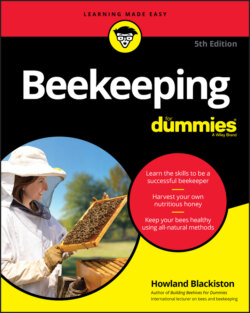Читать книгу Beekeeping For Dummies - Howland Blackiston - Страница 79
Overcoming Sting Phobia
ОглавлениеPerhaps the best-known part of the bee’s anatomy is its stinger. Quite honestly, that was my biggest apprehension about taking up beekeeping. I don’t think I’d ever been stung by a honey bee, but I’d certainly felt the wrath of yellow jackets and wasps. I wanted no part of becoming a daily target for anything so unpleasant. I fretted about my fear for a long time, looking for reassurances from experienced beekeepers. They told me time and again that honey bees bred for beekeeping were docile and seldom inclined to sting. But lacking firsthand experience, I was doubtful.
The advice turned out to be 100 percent correct. Honey bees are docile and gentle creatures. To my surprise (and delight), I made it through my entire first season without receiving a single sting. In the decades that I’ve been keeping bees, not a single member of my family, not a single visitor to my home, and not a single neighbor has ever been stung by one of my honey bees.
By the way, bees sting — they don’t bite. Honey bees use their stinger only as a last resort to defend the colony. After all, they die after stinging a person. When bees are away from the hive (while they’re collecting nectar and pollen), defending the colony is no longer a priority, so they’re as gentle as lambs out in the field, unless, of course, accidentally stepped on.
Do I ever get stung? Sure. But usually not more than three or four times a year. In every case, the stings I take are a result of my own carelessness. I’m rushing, taking shortcuts, or am inattentive to their mood — all things I shouldn’t do. (I really should read this book more often!) My sloppiness is merely the result of becoming so comfortable with my bees that I’m not as diligent as I should be. The secrets to avoiding stings are your technique and demeanor.
Here are some helpful tips for avoiding stings:
Always wear a veil and use your smoker when visiting your hive (see Chapter 5 for more information on these two vital pieces of beekeeper apparatus).
Inspect your bees during pleasant daytime weather. Try to use the hours between 10 a.m. and 5 p.m. That’s when most of the bees are out working, and fewer bees are at home. Don’t open up the hive at night, during bad weather, or if a thunderstorm is brewing. In Chapters 7 and 8, I go into detail about how to open the hive and inspect the colony.
Don’t rush. Take your time and move calmly. Sudden movements are a no-no. That sudden jerk of your hand away often provokes, rather than avoids, a sting.
Keep a good grip on frames. If you drop a frame of bees, you’ll have a memorable story to tell but not a happy one. Also, city roofs are often covered in reflective paint, which gets very hot. The high temperatures will damage the bees’ feet and/or wings. A bee landing on a city rooftop is not the same as landing on a lawn. Perhaps lay a cloth down around the hive before starting an inspection.
Never swat at bees. Become accustomed to them crawling on your hands and clothing. They’re just exploring. Bees can be gently pushed aside if necessary.
When woodenware is stuck together with propolis, don’t snap it apart with a loud “crack.” The bees go on full alert when they feel sudden vibrations. Gentle and slow is the way to go.
Bees don’t like loud noises and vibrations, so don’t locate your city bees near noisy compressors, air conditioners, or anything else that might make them cranky.
Never leave sugar syrup or honey in open containers near the hive. Doing so can excite bees into a frenzy, and you may find yourself in the middle of it. It can also set off robbing — an unwelcome situation in which bees from other colonies attack your bees, robbing them of their honey. In Chapter 10, you find instructions on how to avoid robbing and what to do when it happens.
Keep yourself and your bee clothing clean. Bees don’t like bad body odor. If you like to eat garlic, avoid indulging right before visiting your bees. Chapter 7 has some handy hygiene hints.
Wear light-colored clothing. Bees don’t seem to like dark colors.
